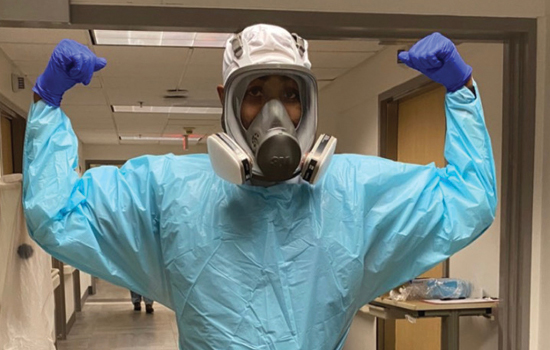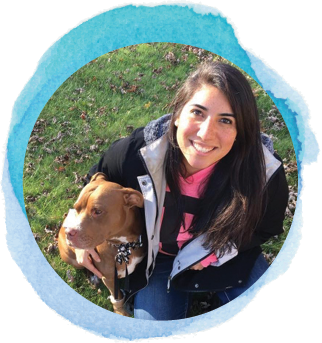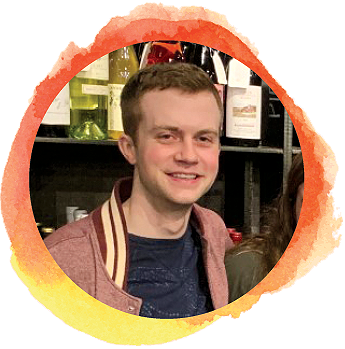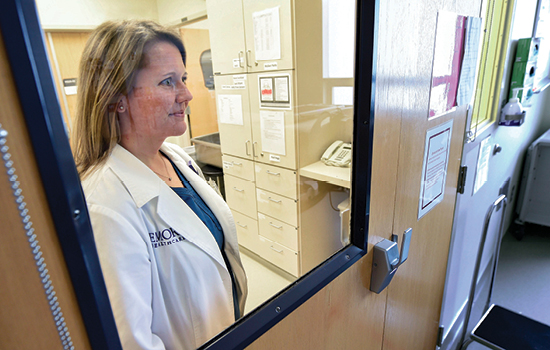Emory nurses take the lead in challenging times

For better or worse, everyone now has their own coronavirus story, no matter what our circumstances. Emory’s Nell Hodgson Woodson School of Nursing (NHWSN) has stories, too; through myriad perspectives. Read on to meet an alumnus doing life-saving work in New Orleans; get to know some students through their stories of keeping their community together despite upheaval; and hear the latest from an Emory Healthcare nurse-leader who leads others in combatting deadly viruses. Visit emorynursingmagazine.emory.edu for even more stories, including a look at how the School’s faculty, staff, and leadership came together to keep students safe, move classes and clinicals completely online, and ensure more than 130 students graduated on time in May.
 “It feels like we’re in wartime here . . . my colleagues and I are stretching our scope of practice, going above and beyond our normal work.”
“It feels like we’re in wartime here . . . my colleagues and I are stretching our scope of practice, going above and beyond our normal work.”
Breathing Room
Donté Flanagan brings critical expertise to help coronavirus patients
By Roger Slavens
Donté Flanagan 04Ox 06N MS DNP has one of the most difficult jobs on the front line of fighting COVID-19. As a certified registered nurse anesthetist (CRNA) based in hard-hit New Orleans, he’s been asked to cover emergency rooms and intensive care units to help in performing one critical task: Keep patients breathing.
“It feels like we’re in wartime here,” says Flanagan, who works at Touro Infirmary for LCMC Anesthesia. “My CRNA colleagues and I are stretching our scope of practice, going above and beyond our normal work in operating rooms. Since most elective surgeries and procedures have been postponed, we’re spending most of our time in ERs and ICUs, performing intubations, titrating sedation and paralytics, and administering mechanical ventilation.”
Intubation, in particular, is not only an unpleasant experience for patients, but also a tricky, specialized procedure.
“On paper, it seems like a straightforward, step-by-step technique, but in practice every case is different and presents unique challenges,” Flanagan says. “With some COVID-19 patients, we are seeing swollen or narrowing airways. Having the experience—and the visual expertise at recognizing the differences in anatomy by sight and feel—is critical in reducing the number of attempts. Extra attempts can further compromise or damage the airway.”
Flanagan estimates that he’s performed 10,000 intubations so far in his 10-year career as a nurse anesthetist, compared with a non-specialist who might have only performed 100.
“There is a different level of comfort and expertise that goes with it,” says Flanagan, who serves on Emory’s Nurses’ Alumni Association Board. “There’s a much greater chance at success if we are the first ones to attempt to manipulate the airway. That’s why we’ve been pulled in.”
All of the COVID-19 cases that reach this advanced stage have to be treated with great seriousness.
“We’re seeing patients coming in with pulmonary edema—fluid is building up in their lungs and they’re having a difficult time breathing,” he says. “Their tissues aren’t getting the oxygenation they need, and if we don’t intervene, eventually they go into acute respiratory distress or cardiac arrest.”
And Flanagan knows that even with successful intubation, COVID-19 remains a difficult foe to beat.
“When I intubate a patient struggling with the coronavirus, I do so knowing that in some cases I could be the last person they ever talk to,” Flanagan says.
 “When I intubate a patient struggling with the coronavirus, I do so knowing that in some cases I could be the last person they ever talk to.”
“When I intubate a patient struggling with the coronavirus, I do so knowing that in some cases I could be the last person they ever talk to.”
Surviving the New Orleans Surge
New Orleans’ hospitals saw a huge surge of cases in late March and early April, just weeks after hundreds of thousands of people enjoyed the city’s legendary Mardi Gras celebrations and traditional St. Patrick’s Day Parade despite the news that the coronavirus had reached the U.S.
“I was screaming from the mountaintops about it, mainly because people just weren’t taking the risks seriously enough,” says Flanagan, who’s also worked as a CRNA in Atlanta and New York City. “I guess if you’re young and living in a big city, you feel like you’re immortal or immune and you don’t see the danger until you or someone you know gets sick. I knew the outbreak was going to happen—as did so many of my health care colleagues—but it didn’t matter. Like clockwork, the patients started arriving in droves.”
And although the health care industry predicted it, hospitals weren't fully prepared for the onslaught. “We were caught at first without the setup and the resources to fight the coronavirus,” Flanagan says. “At Touro, we had to convert two of our normal hospital units into isolation wards. And at one point our two main ICUs were completely filled with COVID-positive patients on ventilators. We even had a time where we couldn’t admit any more of them—we could only get them stabilized, intubated and on a ventilator, and then have to ship them to another hospital that had room.”
Over time, the city and its hospitals began to work more collaboratively and the outcomes improved, Flanagan says. “More units and floors in hospitals were turned into ICU units,” he says. “We were able to borrow ventilators from pediatric wards and hospitals where they weren’t being used. We got better at using and reusing personal protective equipment (PPE).”
While the first surge of COVID-19 patients has slowed, Flanagan hopes they’ve learned enough to be prepared for future waves.
Heavy Toll on Health Workers
Seeing so many patients in dire shape levies a heavy mental toll on Flanagan and his fellow front-line workers. “It’s difficult witnessing the outcomes, watching people suffer or even die alone since their families can’t visit them with the heightened restrictions in place,” he says.
Additional stress comes from being forced to work long shifts and the increased risk of becoming infected himself.
“Our shifts are very fluid, changing daily, and my days off are not necessarily guaranteed,” Flanagan says. “And when staff members test positive for the coronavirus and have to be quarantined, that pulls them out of the rotation and puts a heavier load on the rest of us. I don’t even look at my weekly schedule anymore—maybe just two days out at most—because it’s likely to change. This is a lot different from my pre-COVID job where most of my work was on a regular schedule and predictable, except for having occasionally to cover labor and delivery.”
Flanagan tries to maintain a positive attitude and remain in good spirits, but the daily grind of COVID-19 makes it difficult.
“I’m still coming in to work, still heeding the call to serve others in need, but there’s a sense of anxiety you can’t entirely escape,” he says. “We’re all wearing masks and gloves and maintaining our distance from each other as best we can. However, we do so knowing we could get infected because of the tiniest slip we make in protecting ourselves. At the same time, the whole atmosphere has changed in the hospital—the isolation doesn’t just happen at home. We’re wearing our masks in the lounge unless we’re eating. It’s hard to hold a conversation when you’re geared up. It’s hard to stay connected.”
When Flanagan does get some time off, he has two rules: No discussing his work and no watching the news. He’d rather decompress and spend quality time at home with his fiancé. “We’re getting to know each other even better by going through this together,” Flanagan says. “She’s been my solace.”
Still, Flanagan says, he had to tell his fiancé from the start that they both had to live as if they had tested positive for COVID-19 and were likely carriers—even if they exhibited no symptoms. That’s meant they’ve had to keep their exposure to the outside world as low as possible.
“I know it's the best way to treat it to avoid spreading the risk to others given the high risk I have for being infected,” he says. “It wouldn’t be fair.”
Alexis Perkins 20BSN
 |
On a warm and sunny spring day, the president of Emory Nursing’s senior class, Alexis Perkins 20BSN, spread out her schoolwork and prepared to get to work in a new office—the backseat of her mom’s silver Toyota Camry, parked in her parents’ driveway. She opened the car windows, made sure her home’s wifi reached her laptop, and logged into class.
“It was really nice to get some fresh air and have a change of scenery,” Perkins says without sarcasm. A month before, she and her classmates had received notice that Emory’s campus was closing because of COVID-19 and Perkins had hurriedly packed her belongings, hauling them the 30 miles back to her childhood home in Loganville, Georgia. It was an unceremonious and abrupt ending to a college experience she had loved. “It was hard, a very emotional time period—our world was flipped upside down,” Perkins says.
Since then, Perkins, along with more than 130 other students, graduated on time. “I’ve heard a lot about how other schools treated their students during the pandemic, and I’m really glad I was at Emory when it happened. All our professors and administrators were so supportive with whatever we needed, even if it wasn’t related to class. Professors made themselves available to us, whether it was staying later after Zoom meetings, or having office hours or being on their emails later than the usual time—even if we just felt like it was all too much and we needed someone to talk to, they were there for us. There was so much support to help us get through that time.”
Perkins is continuing to work PRN as a Patient Care Specialist for pediatric patients with blood disorders, cancer, and those requiring a bone marrow transplant at the Egleston Hospital campus of Childrens’ Healthcare of Atlanta (CHOA) in Atlanta. “As a health care provider, you see a lot of scary things,” she says. “But throughout nursing school, we’ve talked about how to protect ourselves, so for me I feel like I’ve trained for this and this is what my education has prepared me for.”
She hopes to start her planned residency with CHOA later this summer. —Dana Goldman

Kartis Connors 22ABSN
 |
Kartis Connors 22ABSN wishes she could be on the front lines. The former EMT was halfway into her first semester at the School of Nursing and had earned a nurse externship job at Emory Healthcare when COVID-19 shut down Emory’s campus and sent her back home to Florida. “I took a spring break trip, with one backpack and my laptop, and ended up staying for the whole summer,” she says.
Connors managed to stay motivated despite the abrupt changes that came with the pandemic. “The transition was hectic,” she says. “Everybody was very stressed. Focusing on time management, making sure I’m not missing assignments or Zoom classes was a challenging adjustment.”
Still, Connors counts her blessings, starting with Emory faculty. “The professors have done an amazing job. We were all very confused at first with everything going on. As soon as they had answers, they were communicating them to us. With exam and assignment changes, classmates in different time zones all over the world, and this entire transition to online classes—the professors have been very accommodating.”
She’s also grateful for classmates, and continues to keep up with them as they move into summer sessions. “We’re very close and have group chats to make sure that everyone can stay on top of things. We’re holding each other accountable, and I couldn’t do it without them.”
Connors is excited to get back to Atlanta for fall classes, although the University has not determined how classes will be held.
Still, COVID-19 and the unusual start to her nursing education has not deterred Connors from her goal of becoming a nurse. “I like working with people and being there for them,” Connors says. “It’s why I chose this field. You’re going to put yourself at risk in a lot of careers, but if you’re passionate about something it overweighs those risks. This is really scary but we’re learning so much from it.” —Dana Goldman
Rachel Querido 21ABSN
 |
Rachel Querido 21ABSN was enjoying starting over. After seven years of serving in the military, the army captain was loving her first semester at Emory’s School of Nursing. “As a military officer I couldn’t necessarily be friends with everyone because of the rank structure,” she says. “But at Emory I’m equal to everyone and made friends quickly. I love it.” In early March, ready to put down roots, she bought a house in Atlanta. Then COVID-19 hit home—literally. In New York, Querido’s father became sick. “He had felt perfectly fine and then six hours later he got hit with fevers, chills, and severe body aches,” Querido explains. Her mother fell ill as well, with a milder form of the illness; happily, both parents have fully recovered and are back to their usual lives.
The past months since have been challenging, to say the least. Querido’s classes went online. Querido helped her sister evacuate back to the U.S. from New Zealand. She began preparing to move to her newly purchased home. And, most importantly, Querido monitored her parents’ COVID symptoms from afar.
“It was tough not being there with my them,” Querido says. While her mother’s illness was limited to body aches and fatigue, her father spent weeks dealing with severe symptoms including difficulty breathing. “We kept measuring his oxygen levels and thankfully he never got to the point of needing a hospital,” Querido says.
One bright spot, she says, is that “my professors have been really supportive.” Professor Helen Baker [PhD MSc, FNP-BC], who teaches bioethics, has been hosting online gatherings so that the cohort can support one another. And Querido is grateful for her schoolwork. “Studying is keeping me busy. I need to do well in school, and I have to pay attention to what I’m learning so that when the time comes to be able to practice, I know what I’m doing.”
Happily, Querido reunited with her dad when he came to Atlanta in May to help her with her new home. “I gave him the biggest hug—and can’t wait to see my mom, too” she says. —Dana Goldman

Adam Bullock 20ABSN
 |
“I was really loving clinicals,” says Adam Bullock, remembering life before COVID-19. This spring, before the pandemic hit, Bullock was at Children’s Hospital of Atlanta for his pediatric rotation. “Going to the hospital was what I looked forward to every week. It’s always really fun to apply what I’m learning in real time.”
Now, Bullock’s life has narrowed considerably. His rotations became virtual simulations. In addition to clinicals, the School of Nursing’s summer immersion trips were also cancelled. Bullock had been looking forward to providing healthcare to farmworkers in Moultrie, Georgia. “I had to delete everything from my calendar,” he says.
One bright spot, however, is that the immersion cancellation made room for him to work Sundays at the Clarkston Community Health Center, just outside of Atlanta in Clarkston, Georgia. Bullock helps with logistics and some patient screening with questionnaires for COVID-19 testing.
Bullock is doing his best to practice self-care. “I cook more than I used to,” he says. “I’ve started baking some. I take a lot of time away from the computer, especially on days I don’t have classes or upcoming deadlines. And I’m staying in touch with friends and trying to keep each other emotionally as normal as possible.”
It helps, Bullock says, to be so inspired by nurses working so hard. “I feel good about the people I go to school with and the program I’m in. Everyone is very much interested in what’s going on and isn’t scared to be a nurse. I’m so proud to be going into nursing when I see all the nurses and advanced practice students persevering through all of this and going to work and doing the job they signed up for,” he says. “The only thing I wish I could change right now is that I wish I could be helping. I wish I could be on the front lines with them.” —Dana Goldman
 In this file photo taken before the 2020 pandemic, Vanairsdale pauses at the door of a patient room.
In this file photo taken before the 2020 pandemic, Vanairsdale pauses at the door of a patient room.
Back to the Front Lines
Vanairsdale leads colleagues in adapting to a new normal
By Dana Goldman
We can never assume that our environment is clean,” says Emory nurse Sharon Vanairsdale 18DNP APRN. As program director for the Serious Communicable Diseases Unit at Emory University Hospital, if anyone is at the center of Emory’s COVID-19 response, it’s Vanairsdale.
For nurses and health care providers coming from other specialties, Vanairsdale says that the coronavirus pandemic is a crash-course in infection prevention and control. “We must be very intentional with our environment and movements. We need situational awareness about every item we’re about to touch. We must sanitize surfaces before we put things down on them. We have to be very deliberate about how we put on gowns, masks, and gloves and how we take them off.”
Vanairsdale was on the front lines of Emory’s Ebola response in 2014. Now, Vanairsdale is working with colleagues across Emory Healthcare to share her expertise on best practices for treating infectious disease.
“We’re in response mode,” says Vanairsdale, who is also the founding director of education at the National Emerging Special Pathogen Training and Education Center. “Our focus is providing the best care possible for our patients, whether they have COVID-19 or not, and my role is to help support the front-line staff so they can do what they need to care for our patients.” Her 12-hour-plus workdays include daily meetings with infection prevention managers and twice-daily incident command meetings. Vanairsdale also collaborates with Emory Healthcare colleagues to trouble-shoot supply chain issues, operationalize social distance and masking guidelines, clarify how and what to communicate to staff, and strategize on how to ensure the health and well-being of patients without the coronavirus.
Vanairsdale has been pleased to see her colleagues adapting so quickly to the new normal. “It’s so cool to see staff, especially nurses, figuring out operating procedures that work for them. On some units, they've taped the floors to know where to walk and where not to walk. What we do in one location isn’t always translatable to another, so they’re thinking creatively and coming up with workflows that allow them to provide the best care possible.”
While her days are long, Vanairsdale says she is inspired by her colleagues and the larger community. “I have never been prouder to be a nurse. I hope everyone knows there are amazing individuals providing amazing patient care, with teams working behind the scenes to support them. It’s an incredible, yet challenging time to be in health care. It’s inspiring for sure.”

Creature comforts
By Dana Goldman
In the middle of an online class last spring, Kartis Connors 22ABSN began receiving texts from classmates: “Bring Butters back in the picture!” Butters, her dog, had been visible beside her for just a minute, and her classmates wanted to see more of the pup. “Show your dog!” they texted.
As Emory nursing courseworkwentonline, cohorts of Emory nursing students inundated their virtual classrooms and group messages with photos of their most loyal study buddies–their dogs and cats.
“I remember in one of our first online lectures, someone started sharing pictures of theirdogs and that was that,” Adam Bullock 20ABSN says. “A few of our classmates have been bold enough to ask to see our professors’ dogs and cats as well.”
“Within our lectures, our professors ask, “who’s hanging out with their dog or cat?” says Rachel Querido 22ABSN, dog mom to Talia, a three-legged pit bullmix. “It’s super cute.”
Assistant clinical professor Ann Horigan PhDRN has been a willing contributor to the pet show-and-tell. Last semester, Horigan taughtNursing in Complex Care Situations. During their last in-person class of the semester, Horigan told students she was getting a new dog. When classes re-convened virtually after spring break, it only felt right to introduce them to Bella, her new French Bulldog.
“Animals are great relievers of stress,” says Horigan.“Teachers can help decrease stress levels in students by taking just a minute to introduce animals in virtual class.”
For Alexis Perkins 20BSN, meeting Horigan’s new dog was a welcome momentof pleasure during a challenging time. “I’d had difficulty sleeping—and this was an 8:30am class. It was nice to see something to make your heart feel warm. You could see people smiling. It was really sweet.”
 Bella Horigan's appearances via Zoom were immensely popular
Bella Horigan's appearances via Zoom were immensely popular
